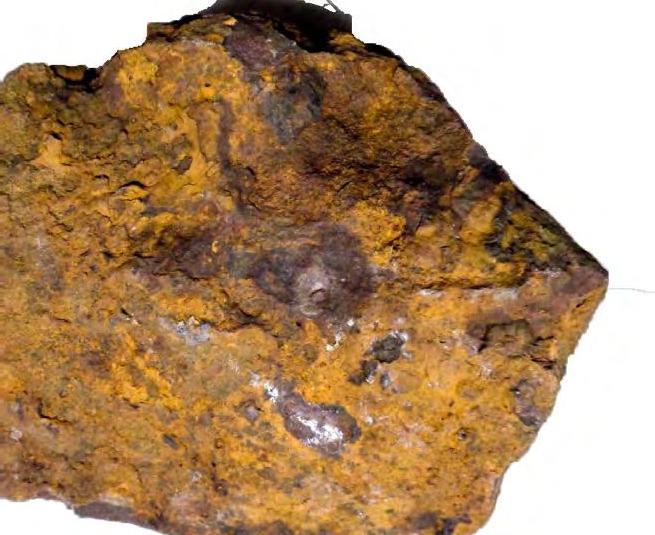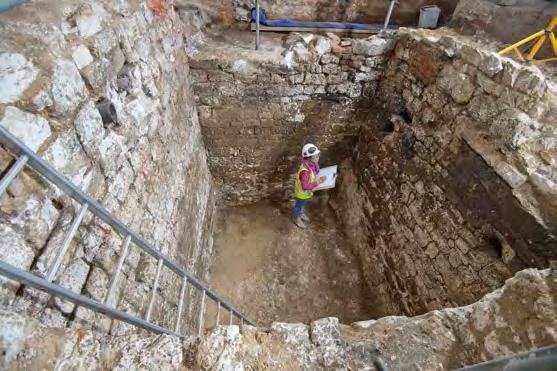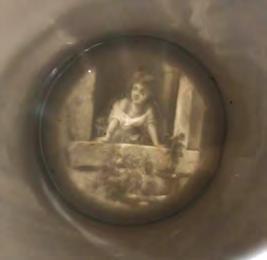
5 minute read
Lost & Found
Golden aureus coin featuring a bust of Allectus, the Roman emperor who ruled Britain as an independent nation from 293 to 296 AD, during the time of the Roman Empire. Photo ©The Trustees of the British Museum.

Any metal detector enthusiast would be happy to stumble across a 24-carat gold coin, but a 1,700-year-old one found in a field in Kent, England, proved a particularly fascinating discovery. While investigating his new home, a man in England recently discovered that there was an entire secret room hidden under his house. And, after investigating the items he found inside the room, it’s possible that this secret basement could be over 100 years old. “It had been used as an easy space, to hide the waste from renovating the property’s roof, guttering, doors, and windows many years ago before being covered up,” he explained. “As I moved deeper into the cavern I began to search for evidence that would tie it to
That’s because it features the Roman Emperor Allectus, who forced the “original” Brexit by breaking away from the Roman Empire and ruling Britannia and northern Gaul as an independent nation between 286 and 296 AD. At London auction house Dix Noonan Webb, it was expected to fetch no more than $127,000, but it sold for $700,000, becoming the most expensive Roman coin minted in Britain ever sold at auction. (Sarah Cascone, December 25, 2019, https://news.artnet.com/art-world/11-biggest-art-and-archaeol

ogy-discoveries-2019-1736265) a grouping of years, so as I could more accurately determine how long it had been covered up. In the dark I collected bottles, paint cans, and my golden find was the remains of a newspaper, though was more comparable to mushy silt.”
Jake Brown says that he measured the newly discovered room and found that it was 16 feet deep, about 10 feet high, and nearly 10 feet wide. (SWNS)
The bottles were reportedly etched with detailing common to the early 1900s. While the newspapers were mostly ruined, Brown says that he was able to eventually work out a date on the papers tying them to the 1960s, suggesting that the room had been sealed since then. (By Michael Hollan | Fox News, https://www.foxnews.com/ lifestyle/new-homeowner-discovers-secret-cellar-120-year-old)
A man digs up boulder in his garden, not realizing that it was a historic meteorite. A rock discovered in a garden in Germany has been confirmed as the largest stony meteorite ever found in the country.

The space rock, which weighs 66 pounds, was discovered more than 30 years ago in a garden in Blaubeuren, in southern Germany. “In 1989, a homeowner was digging a cable trench on his property in Blaubeuren, in the German region of Swabia, when his spade hit a rock,” explains the German Aerospace Centre (DLR) in a statement. “Upon lifting it half a meter [1.6-feet] to the surface, he found that it was remarkably heavy.” The rock, which is a chondrite, or stony meteorite, measures 11 inches by 9.8 inches by 7.9 inches.
The man held a magnet to the rock and confirmed that it contained iron.
“The angular boulder was then left lying in the garden for decades,” DLR added. “Only 31 years later did it occur to the finder that it might be a visitor from space.”(By James Rogers | Fox News https://www.foxnews.com/science/boulder-historic-meteorite-germany)

Do These 10,000-Year-Old Flint Artifacts Depict Human Figures? New research suggests 10,000-year-old flint artifacts found at a Neolithic burial site in Jordan may be human figurines used in a prehistoric cult’s funeral rituals. If confirmed, the trove of more than 100 “violin-shaped” objects would be one of the Middle East’s earliest known examples of figurative art, reports Ariel David for Haaretz.
The group of Spanish researchers, led by Juan Ibáñez of the Milà y Fontanals Institution of the Spanish National Research Council, were digging at Kharaysin when they came across the roughly two inch-long figures. Ibáñez and his team published his results in the journal Antiquity. When the first few figurines were discovered, a member of the team suggested that perhaps they were humanoid figures, a proposal that was met with much laughter. Ibáñez reported to Tom Metcalfe that, “The team reacted… with jokes about how much sun he had received on his head.” But as more and more figurines were unearthed, the suggestion became increasingly plausible. (Candida Moss, https://www.yahoo.com/news/ whats-obsession-depicting-people-die-091636791.html
Chip Cable found this very interesting brewery Mug recently. "Neat brewery mug I picked up.
It has a lithophane in the base".
Pre-Pro from Washington D.C. Centuries of Crap and Some Historical Treasures in an Old London Cesspit. An art museum found a very old toilet—right under where its new bathroom was being built. IN THE 15TH AND 16TH centuries, London was not a pleasant place to poop. The city was bustling with people and light on sewers, which means it was just teeming with excrement. Many, many residents had no choice but to squat over communal cesspits—deep openings in the ground often covered with wood planks cut with butt-sized holes. When the pits reached capacity, people either closed them up and dug fresh ones or called for a “gong farmer,” a poor sod who scooped them out and carted the mess away, often to the nearby Thames or Fleet River, waterways that often seemed to be more waste than water.

The scientists found that the structure had walls up to three feet thick and a gravel base. A latrine was built in one corner in the 18th century, after the rest of the pit had been filled in, meaning that, from the Saxon era to the 18th century, people had been pooping on the same site for hundreds of years. (BY JESSICA LEIGH HESTER FEBRUARY 6, 2020, https://www.atlasobscura.com/articles/london-cesspit-history?utm_medium=atlas-page&utm_source=facebook. com&fbclid=IwAR0P-VyjYz0y9MK5mdorRAsPy8_noQwh_E29S
rX3Kb5aGFNB_xgr9Smw6Z4




Recently found in Indiana, this beautiful yellow green Pinetree Cordial in a early rare mold. Buyer says, there are still wonderful things to be found in the wild!








